By Deneece Ferrales
Feb. 7 is National Black HIV/AIDS Awareness Day. Uriah Robertson and the team at Waco-McLennan Public Health District who work in the clinic for HIV/AIDS services are preparing to use the occasion to raise HIV/AIDS awareness and encourage testing.“

Studies show that African Americans make up about 45 or 47 percent of new HIV diagnoses,” Robertson said. “Amongst women, we are seeing that African American women are 57 percent of new diagnoses. So, how do we decrease the numbers? We have to educate, advocate, encourage routine testing and so much more.”
As a risk reduction specialist, Robertson said his job is to “work with the community to provide intervention and prevention tools. We even perform HIV testing and encourage the importance of knowing your status.” Risk reduction specialists “have those conversations that others are afraid to have. We work to build rapport with our clients so we can get out into the clinic so that we can get the word out about our services while also working to break down the walls of stigma about HIV/AIDS.”
According to HIV.gov, a website managed by the U.S. Department of Health and Human Services, he first Black HIV/AIDS Awareness Day was held in 1999 as a grassroots opportunity to raise awareness in minority communities. In 2001, the day was given national status. This became needed as the number of new infections were disproportionately affecting people of color, particularly Black communities. At that point, new cases of HIV were escalating so quickly in the Black community that national leaders and the Centers for Disease Control began concerted efforts to combat the spread of HIV/AIDS in communities of color. According to the CDC, the history of these efforts includes:
- In 1998, the Congressional Black Caucus joined African American leaders from all over the U.S. to declare a “state of emergency” and created the Minority AIDS Initiative to offer funding for prevention efforts in Black communities. The CDC launched an array of prevention efforts aimed at preventing the spread of HIV among African Americans as a result of this funding.
- In 2000, HIV cases among Black and Latino men exceeded cases among White men, which was disproportionate to the general population, thus calling attention to health inequities surrounding the spread of HIV/AIDS.
- In 2007, the CDC launched its expanded HIV testing initiative to increase testing opportunities, primarily among African Americans.
- In 2008, the Black AIDS Institute reported that if Black America were its own country, it would rank 16th in the world in terms of number of people with HIV. It was estimated that 1 in 16 Black men would contract HIV/AIDS in their lifetime (approximately 6% of the population) and 1 in 32 Black women would contract HIV/AIDS in their lifetime.
- In 2010, the Obama Administration released first National HIV/AIDS strategy for the United States, which called on the nation to focus HIV prevention efforts on those at greatest risk, including African Americans.
Despite these efforts, sadly, this has not changed in the past 23 years. African Americans, more than any other race, have the highest rates of HIV infection in the nation. Black Americans account for approximately 14% of the U.S. population, but nearly half of those living and dying with HIV and AIDS are Black. Within this population, gay and bisexual men are the most affected, followed by heterosexual women. AIDS is the third leading cause of death among Black women aged 25–34 and 35– 44 and among Black men aged 35–44 (CDC).
Not only does this health inequity appear in the number of African Americans contracting HIV/AIDS, it also appears in the treatment of HIV/AIDS. Compared to all other persons with HIV, African Americans had the lowest rates of viral suppression. According to the CDC, out of every 100 Black persons living with HIV, only 63 are receiving some type of HIV care, 48 of 100 were retained in HIV care, and 51 of 100 were virally suppressed. This means that little more than half of all African Americans living with HIV received any type of treatment.
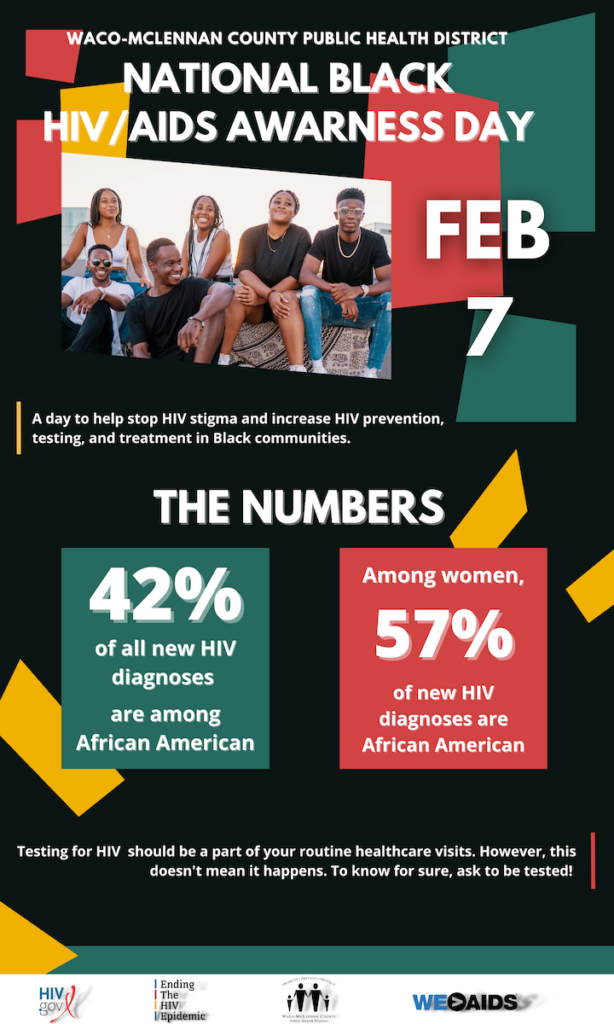
Though HIV is preventable, prevention remains the biggest challenge and further calls attention to the health inequities around this disease in Black communities. The challenges to prevention efforts include the stigma of a positive HIV status, people not having awareness of their HIV status, homophobia, racism, and mistrust of the healthcare system.
Lack of awareness of one’s HIV status can also lead to poor HIV treatment outcomes. Further, STI rates among African Americans are higher than among any other minority group, and there is a link between being diagnosed with other Sexually Transmitted Infections (STIs) and contracting HIV.
Lastly, persons experiencing poverty, which is higher in Black communities, are less likely to have access to quality healthcare for HIV, stable housing, and HIV prevention services.
So where do we start in addressing this health inequity? The most important place to begin is to encourage testing. If HIV is left untreated, chronic illness and death are the likely outcomes.
The first step to preventing this is for a person to know his or her status. Knowing one’s status can also prevent the further spread of HIV. Health professionals must continue to partner with Black community leaders to make outreach efforts aimed at more testing and increased awareness of prevention.
HIV treatment and prevention has come a long way in the past three decades. On Feb. 7, it is important to increase awareness of the continued need to address HIV prevention and treatment, particularly in Black communities. This is also a great day to encourage testing and the importance of knowing your status. Together, we can continue that fight to eradicate HIV/AIDS.

Deneece Ferrales, Ph.D., is director of health initiatives for Prosper Waco.
The Act Locally Waco blog publishes posts with a connection to these aspirations for Waco. If you are interested in writing for the Act Locally Waco Blog, please email the ALW team — [email protected].
By Deneece Ferrales
For many of us, the new year means time to set our new year’s resolution(s) — a goal or set of goals that are generally designed to help one become happier, healthier, more successful, and/or have increased life enjoyment. According to several studies, health goals are the most common resolutions.

In the United States, exercising more, losing weight, and better mental health are among the top five resolutions every year. These are important, especially in light of the COVID pandemic continuing to limit our contact with others and limiting how and when we can participate in healthy activities such as exercise or even the ability to access healthy foods.
Keeping up a healthy exercise routine and healthy eating are imperative both to our physical and our mental health. Unfortunately, despite our best intentions, many of our resolutions will be abandoned before January ends.
The collective wisdom regarding resolutions has always been that discipline is key and that if we fail at keeping a resolution, it is because of poor self-discipline. However, simply telling ourselves to do it does not lead to success. According to US News & World Reports, we normally set resolutions based on our Christmas excesses (eating, failing to get exercise during the holidays, etc.) without preparing ourselves for the changes we plan to make in our lives.
There is a discomfort that comes with change, even when that change leads to feeling better. We have to readjust our schedules for exercise, amend our shopping habits to seek out healthier foods, or make other intentional changes to our daily routines and habits. This is stressful because the act of change, any change, produces emotional friction.
If we have not determined when and how we plan to exercise or made a plan for any grocery shopping changes needed to be able to purchase healthier foods, then we are doomed to fail when we experience that transient discomfort. It is important to plan for the change and give yourself a step-by-step guide to when and how each change will occur. Even with the best plans, transient discomfort will occur, but it is much easier to follow a well-thought-out plan through the change than to add further stress from indecision.
Here are some tips for keeping those healthy new year’s resolutions:
- Turn your broad health resolutions into specific goals with steps for accomplishing those goals. I like using SMART goals (specific, measurable, attainable, realistic, and timed). SMART helps us think out exactly how and when we plan to make our changes and then gives us time limits for accomplishing our goals. So instead of having a resolution that says, “Get more exercise,” your resolution reads, “Take a mile-long walk 4 times a week for the next three months.”
- Think small. Set your goals for something accomplishable. You may want to run in next year’s marathon, but you have not begun to train yet. Setting a goal that is not reachable or that will require work over a long period of time is likely to lead to disappointing results and goal abandonment. It might be better to start with a smaller goal, like running a mile or running 3 times a week, and as you reach each goal, set another until you are ready to run that marathon.
- Consider your why. Setting goals that lead to better health is always a good idea. The meaning of those goals is different for each person. One person may be diabetic and interested in lowering their A1C, while another person may want to increase stamina to be able to participate in more activities. Whatever your reason, this can be what keeps you motivated on those days when you are not feeling it. If your goals revolve around exercise and/or healthier eating, try to stay away from an appearance-focused why.
- Keep it all in the family! Parents have to consider their children’s needs, which are sometimes unpredictable. Setting a health resolution for the whole family makes reaching your goals a “family affair” and prevents you from having to choose between your family and your own personal growth.
The Robert Wood Johnson Foundation published a report titled, “State of Childhood Obesity: Prioritizing Children’s Health During the Pandemic.” The report states that more than 15% of children (1 in 7) between the ages of 10 and 17 are obese. Childhood obesity leads to a host of health problems in adulthood. For this reason, including the children in developing healthy goals now will give them a foundation for continuing healthy practices.
If setting a family health resolution, call a family meeting so everyone has input. Define what a resolution is so that the entire family understands the importance of setting the goal. Talk about your family’s good health habits and bad ones to determine the best family resolution.
- Write down your goals/resolutions. Writing down your resolutions helps make your goals more intentional. Looking back at the goals can help motivate you and remind you how far you have come toward achieving your goals.
- Share your resolution with others. Telling other people about your goals can help hold you accountable. It can also help you find others who are working on similar goals so that you can achieve them together. Find someone else who wants to exercise and schedule walks or grocery shop together.
- Use technology to your advantage. There are a myriad of apps for your phone that can support you in your quest to meet your goals.
- Look at your goals frequently and review your progress. There are a number of free goal tracking apps that can assist you with this.
- It’s not over just because you veer off course. We all veer off course sometimes. Maybe you had a bad week and weren’t able to walk or you were not able to shop at your regular grocery store and thus had to buy more pre-packaged and less healthy foods. It’s okay. Look back and celebrate the progress you have made and how far you have come then readjust so that you are able to continue moving forward despite the disruption.
Let’s make 2022 a year of healthier living by learning to plan, set, and achieve our health goals. Have a happy and healthy new year!
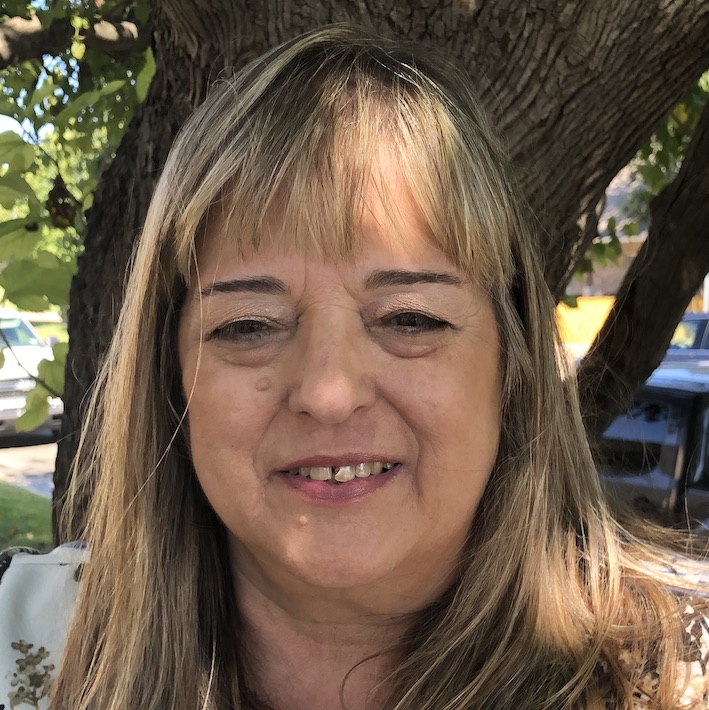
Deneece Ferrales, Ph.D., is director of health initiatives with Prosper Waco.
By Ferrell Foster
Waco may be on the verge of greatness. This thought came to me this morning as I reflected on two true things — our town seems to be facing the reality of its high poverty rate, and we also seem to be taking the arts seriously.
It may seem odd to tie these two things together, so let me try.

No city can be great when such a high percentage of its population lives in poverty. There is all kinds of data to prove this point, but you can also drive into certain parts of town and convince the other side of your brain of this truth.
The poor will always be with us, as someone famous once said, but that did not prevent him from caring deeply and working on behalf of the poor. That guy’s name was Jesus, and people are still talking about him, even worshipping him, 2,000 years later.
So, yes, there will always be people who live in poverty, but that doesn’t mean the rest of us shouldn’t work our tails off helping as many as we can. We help them in the short term by dealing with basic needs (food and shelter), but the most important help comes in the form of education and job training — things related to earning a liveable wage. A minimum wage job cannot support anyone adequately unless they are living with someone else.
And, by the way, our very best schools should be in our very poorest neighborhoods. That’s where it is most needed. But, in Texas, we have the opposite. The best schools are usually in wealthier neighborhoods. Education takes money, even though some don’t like to admit it. Those same people often pay more for housing or private schools for that very reason — it takes money to educate children while parents are working elsewhere.
The other side of this coin is promotion of the arts. This is not often understood as intuitively as the other. We are so enmeshed in a capitalist society that we can easily think business and money-making are the most important parts of building a community. Business and money-making are essential, but addressing poverty and promoting the arts is equally important.
Why the arts? This sector is much like the spiritual sector (of which we already have great strength). Both promote a connection to truth and concerns beyond oneself, and when we connect to deeper Realities we generally become more attuned to the people around us, or we should. Sometimes American religion can be very self-centered (as in “my” salvation) and undermine broader concern, but Christianity and other religions lift love of neighbor to equal footing with love of self. Self-esteem is good (you are created in the image of God), but neighbor-esteem is just as important (they are created in that same image).
More than 100 years ago, Evelyn Underhill understood the connection between spirituality and art. Artists, she said, are “aware of a more vivid and more beautiful world” than other people. They are “always driven by their love and enthusiasm” to express before others “those deeper significances of form, sound, rhythm, which they have been able to apprehend.”
Artists can do this because “they taste deeper and deeper truths, make ever closer unions with the Real. For them, the duty of creation is tightly bound up with the gift of love,” Underhill wrote.
This is why we need artists, just as surely as we need preachers. They help us to connect with the broader realities that many of us identify as God, while others identify it in other ways. This makes, or should make us, better neighbors. And better neighbors make better towns.
And, by the way, the creativity of the artistic mindset can be financially profitable, as well. For proof of this look no further than our very own Joanna Gaines. Joanna’s creativity with Chip’s business sense as built something important that is benefiting many.
Almost 30 years ago, the band Jars of Clay recorded a song titled “The Art in Me,” which included these lyrics:
“Sculpting every move
You compose a symphony
And you plead to everyone
See the art in me
See the art in me
See the art in me.”
(Songwriters: Charlie Lowell / Dan Haseltine / Matthew Ryan Bronleewe / Stephen Daniel Mason)
May we see the art in each other and work to help each other, both in our struggles and in our art.
Ferrell Foster is senior specialist for care & communication with Prosper Waco. He is also on the Board of Directors of Act Locally Waco and a regular contributor to the blog.
The Act Locally Waco blog publishes posts with a connection to these aspirations for Waco. If you are interested in writing for the Act Locally Waco Blog, please email the ALW team — [email protected].
By Deneece Ferrales
One-quarter of Waco residents did not see a physician for any type of routine services in 2018, the last year for which such data is available. Data from the City Health Dashboard indicates many residents do not have a primary care physician or a “medical home.”
To help more Wacoans access care, Prosper Waco’s Access to Healthcare Working Group has planned an event, “Christmas on Memorial,” 4-7 p.m. Tuesday, Dec. 7, at the Family of Faith Worship Center, 4112 Memorial Dr. The event is a partnership between the church, McLennan County Indigent Health Care, and other organizations involved with the working group. (More details below.)
The lack of access to primary health care is particularly prevalent in certain Waco ZIP codes that include many lower income and Black and Hispanic residents. The problem not only puts residents at risk but also taxes the healthcare delivery system because the lack of regular healthcare often leads to undiagnosed problems that grow bigger. This leads to urgent care, including trips to the emergency room.
The following graph illustrates the percentage of Waco/ McLennan County residents who have seen a primary care physician within a year and the bullets underneath give the percentages for the most affected ZIP codes.
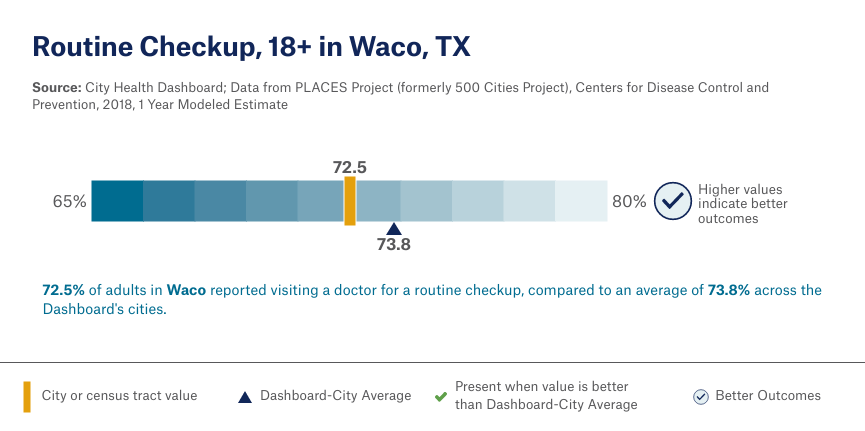
When broken down by ZIP code and census tract, the problem becomes more glaring.
- 76701, Track #1: only 66.6% of adults had a routine checkup in the past year
- 76705, Track #33: only 65.9% of adults had a routine checkup in the past year
- 76706, Track #2: only 66.5% of adults had a routine checkup in the past year
- 76798, Track #3: only 66.3% of adults had a routine checkup in the past year
Participants in “Christmas on Memorial” will have access to the following:
- Groceries for their families;
- Health screening from Ascension;
- Behavioral health screening from Heart of Texas Region MHMR,
- A COVID vaccine;
- Buy and wrap Christmas presents for kids at a reduced cost;
- Be entered into a drawing for prizes, including kids’ bicycles;
- Apply for health insurance and/or health benefits;
- Talk to a number of health agencies and providers about healthcare options and benefits; and
- A visit with Santa or play time in an on-site bounce house, along with an assortment of other kids’ activities.
The event is being held to help our community connect with healthcare resources. This event was planned by the Access to Healthcare Working Group, which is co-chaired by Heather Travers of McLennan County Indigent Healthcare and Deneece Ferrales of Prosper Waco.
For more information about this event or to sign up for a table at the event, please contact [email protected] or [email protected]. Flyers are available for distribution.
If you would like more information about the work of the Access to Healthcare Working Group, you please contact co-chairs Heather Travers or me at the emails above.
Deneece Ferrales, Ph.D., is director of health initiatives with Prosper Waco.
The Act Locally Waco blog publishes posts with a connection to these aspirations for Waco. If you are interested in writing for the Act Locally Waco Blog, please email Ferrell Foster.
By Telawna Kirbie
The City of Waco now has a full-time social worker, DeAngela Bynum, at the Waco Police Department and employed by Prosper Waco. The goal of her work is to connect community members to much-needed social resources and supports as part of PW’s Waco Connect program.

Obviously, one person cannot do this for the entire community, so Prosper Waco has worked with police to choose a particular set of community individuals who will be offered Waco Connect services as a pilot program. This population includes community members who have multiple law enforcement interactions and those that have frequent Emergency Detention Orders (EDOs).
When we say, “multiple law enforcement contacts,” we are referring to those community members for which the police receive multiple calls for minor disturbances and infractions that may or may not warrant police intervention. Some people are the subject of multiple calls in one day and others over a period of weeks or months. These community members may benefit from accessing other social resources to support their overall physical and mental health.
The other subset of the population includes those who have multiple or frequent EDOs. An EDO is when a community member is in a mental health crisis and needs assessment for hospitalization but is not willing or able to go voluntarily. The police have the authority to take the individual into custody and take them to a facility to obtain a psychiatric assessment. Some of our community members find themselves in mental health crises frequently. Waco Connect will work with them to access the resources and supports necessary to reduce mental health crises and promote mental health.
DeAngela receives referrals from within the police department, completes a needs assessment, and then provides linkage and support in accessing, navigating, and obtaining the resources to help meet their needs. Waco Connect can continue to provide ongoing support for as long as needed for up to one year. The desired overall outcomes will be a reduction in law enforcement contacts, EDOs, emergency department visits, hospitalizations, and medical costs as well as an increased level of overall physical and mental health.
Prosper Waco, the City, and the Waco Police Department are excited about what this program can provide as we partner together to provide more comprehensive support for our community members. Stay tuned for more information as we continue to grow and expand Waco Connect services.
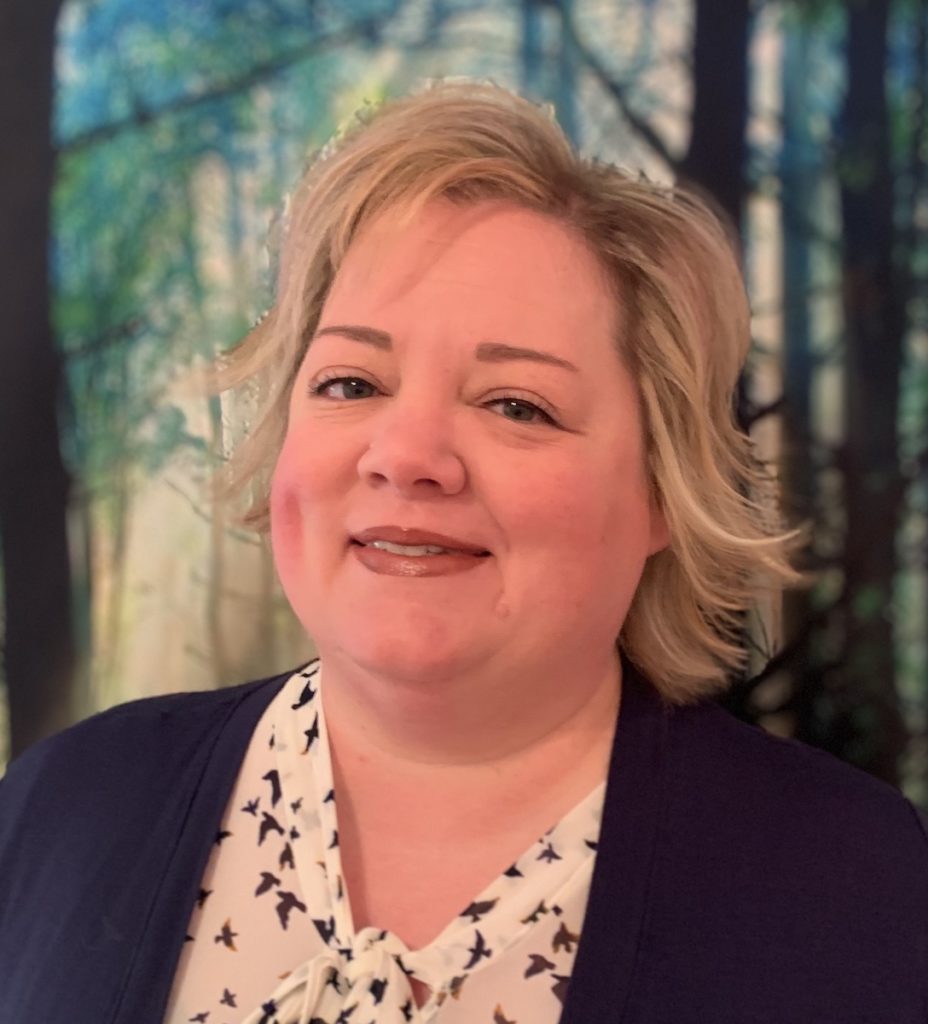
Telawna Kirbie is director of behavioral health initiatives for Prosper Waco.
The Act Locally Waco blog publishes posts with a connection to these aspirations for Waco. If you are interested in writing for the Act Locally Waco Blog, please email Ferrell Foster at [email protected].
By Dexter Hall
During my many readings about financial security and understanding how we arrived at this point in time, I have run across many articles and commentary.
An article by Rocio Sanchez-Moyano and Bina Shrimali, of the Federal Reserve Bank, sheds light on how years of financial exclusion of Black and Brown communities have led to many of our present-day problems and issues. The article, titled “The Racialized Roots of Financial Exclusion,” reveals the fact that access alone is not enough.
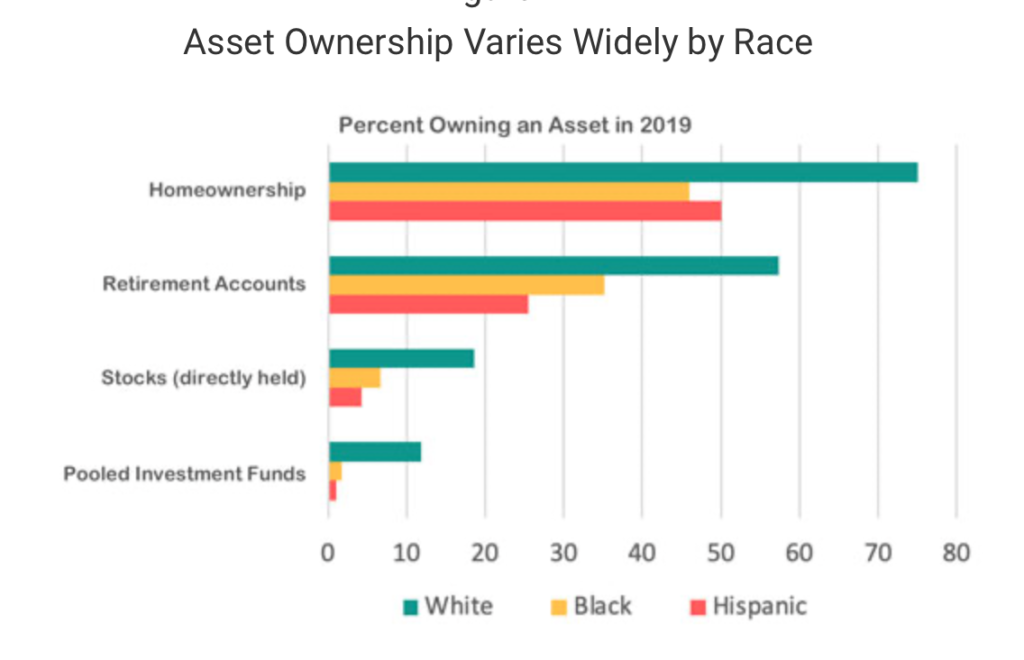
We often share information about redlining and racially restrictive housing covenants that were the law of the land in cities across America that barred “negroes” from buying in areas that were deemed “white” only.
Rocio and Bina share an example from a 1950 covenant on a property in Daly City, Calif. The covenant said: “The real property above described, or any portion thereof, shall never by occupied, used or resided on by any person not of the white or Caucasian race, except in the capacity of a servant or domestic employed thereon as such by a white Caucasian owner, tenant, or occupant” (cited from Richard Rothstein’s The Color of Law: A Forgotten History of How Our Government Segregated America, p. 78‒79).
Rothstein also cited a practice called blockbusting, which “refers to the practice of telling white homeowners that Black people are moving to induce concern about forthcoming declines in property values, which sometimes led to sales at a loss that were then sold to Black people at a profit” (Rothstein, p. 95).
The Rocio and Bina article discusses in extremely clear terms how the Black-White wealth gap came to be. More importantly, the authors help us understand why there is a need for direct investment in communities of color to balance the scale that was tipped purposely and intentionally.
Understanding the intersectionality of financial security to health and educational outcomes continues to be a bedrock of creating a more thriving community for all Wacoans. This is our challenge together in creating an inclusive economy for all.
In straightforward terms, when all people win, we all win. However, when one of our brothers and sisters loses or is left behind, we all lose.
The data we previously shared from the 1934 redlining map shows us where we should expect issues and problems today in Waco because of intentional non-investment in the past. The data today, 87 years later, show large amounts of poverty persist in East Waco and parts of South and North Waco. In other words, today’s poverty map mirrors the 1934 redlining map.
Implementing the City of Waco’s Financial Empowerment Blueprint is needed now more than ever. Let’s act today to change the future of Waco.
For more information on how to get involved in [email protected]. The time is now.
Please look at the full article by Rocio and Bina, as well as the documented research included in their endnotes.
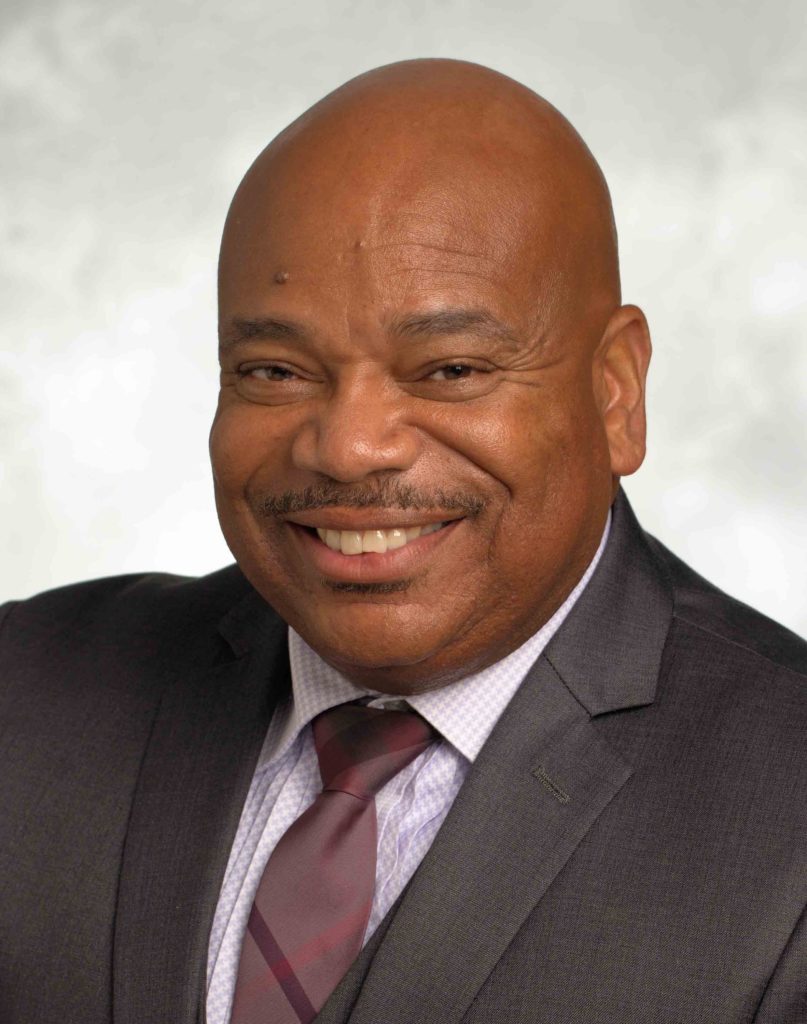
Dexter Hall is chief of staff and senior specialist for financial security with Prosper Waco.
The Act Locally Waco blog publishes posts with a connection to these aspirations for Waco. If you are interested in writing for the Act Locally Waco Blog, please email Ferrell Foster at [email protected].
By Jeremy Rhodes
The first wave of data releases from the 2020 US Census is here, and many of the demographic shifts that we’ve seen across the country and the state are mirrored in our Waco community. In this series of posts, I am presenting some of the demographic changes we see in McLennan County from 2010 to 2020.
The first post presented numbers regarding general population growth and decline. The second post showed an overview of racial and ethnic changes in the county. The third post expanded on the racial/ethnic changes in McLennan County since 2010. In this post, we will look at some of the changes to the housing landscape in Waco since 2010.
This first map shows the number of housing units in each area, as well as the change in housing units since 2010. The orange areas saw a decline in total housing units, with darker shades indicating a larger decline. The green areas saw an increase in total housing units, with darker shades indicating a larger increase. The top number shows the total number of housing units in that area, while the bottom number shows the change in number of housing units since 2010.
Most of central Waco and north Waco saw little change in total number of housing units from 2010 to 2020. The largest growth in housing units was seen in China Spring, with an addition of 1131 housing units, and Hewitt, with an addition of 1,000 units. Only six census tracts saw declines in the number of housing units since 2010. One of the historic East Waco tracts (tract 15) saw the largest decline in housing units, with a loss of 141 households. Most of the county saw moderate to robust housing growth.

The second map is similar to the first. The coloring is the same, with green shades indicating growth in housing units since 2010, and orange shades indicating decline in housing units since 2010. The black number in each tract is different in this map; it displays the number of residents per household in that area. Most of the county has between two and three people per household. Notable exceptions include downtown Waco and historic East Waco, where there are fewer than two residents per housing unit.
There are two outlier tracts that should be explained. In the northwest of the map, you will see a tract with 17 people per household. That tract is the airport, and we should not think too much about housing and population data for that tract. The other outlier is the tract containing Baylor University, which has a “persons per household” of 149.6. Although the Census Bureau does not consider dorms to be housing units, I cannot be certain how they obtained such a high number while excluding dorms from consideration.
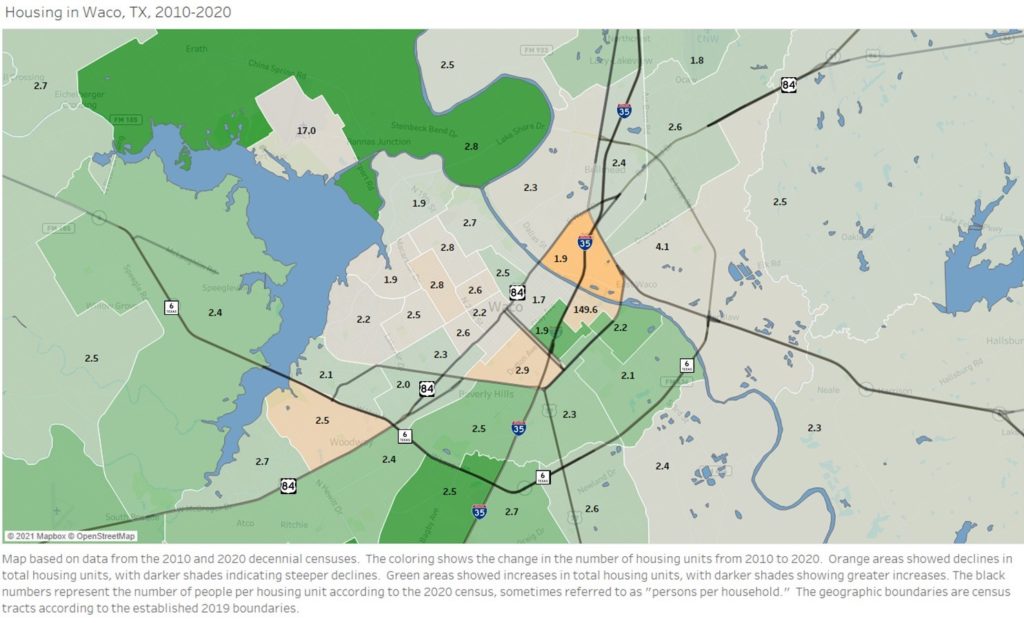
If you have any questions about this, or if you would like Jeremy to give an overview of these changes to your group, staff, or organization through Zoom or in person, please contact Jeremy Rhodes at [email protected].
Jeremy Rhodes, Ph.D., is director of research and community impact for Prosper Waco.
The Act Locally Waco blog publishes posts with a connection to these aspirations for Waco. If you are interested in writing for the Act Locally Waco Blog, please email Ferrell Foster at [email protected].
By Jeremy Rhodes
The first wave of data releases from the 2020 US Census is here, and many of the demographic shifts that we’ve seen across the country and the state are mirrored in our Waco community. In this series of posts, I will present some of the demographic changes we see in McLennan County from 2010 to 2020.
The first post presented numbers regarding general population growth and decline. The second post showed an overview of racial and ethnic changes in the county. This post will expand on the racial/ethnic changes in McLennan County since 2010.
I made a series of maps that show us which parts of Waco have experienced growth and decline for some of the major racial and ethnic groups from 2010-2020, using census tract boundaries. For each of these maps, the orange areas showed decline for that group, while the green areas showed increases for that group. The black numbers represent the percentage of the residents in that tract who identify with that racial or ethnic group, according to 2020 census numbers.
As I mentioned in the previous post, the Census Bureau advises caution when comparing the racial and ethnic composition of 2010 to that of 2020. According to their website, “data comparisons between the 2020 Census and 2010 Census race data should be made with caution, taking into account the improvements we have made to the Hispanic origin and race questions and the ways we code what people tell us.”
The first map shows us Waco’s Latino population. Almost the entire map is green, indicating numerical growth in almost every census tract. “Percent Latino” declined in 4 census tracts, but increased everywhere else in the county. Even areas with a relatively small Latino population, such as China Spring, Speegleville, Woodway, and Hewitt, showed increases.
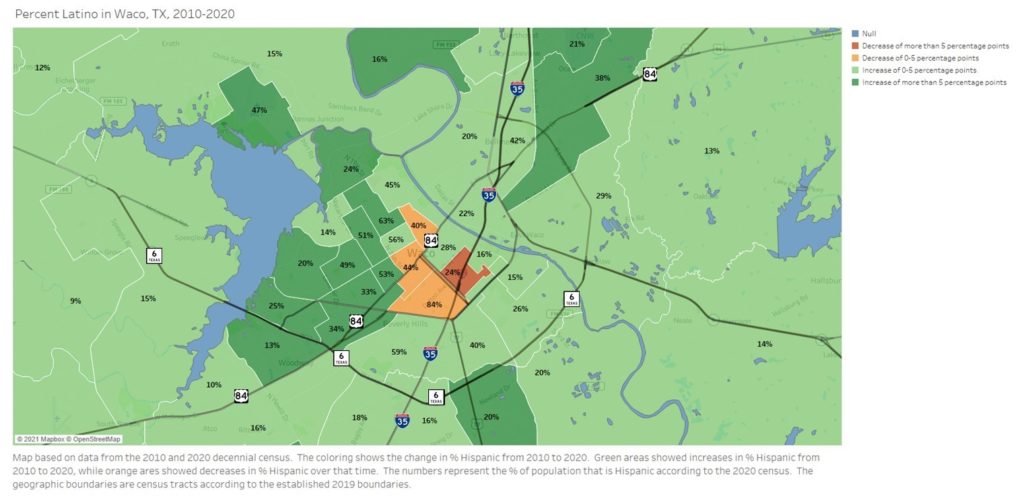
The next map shows Waco’s population who identify as White alone, non-Hispanic. It’s almost the complete opposite of the Hispanic map. Whereas the map of Latinos is almost entirely green, the map of Whites is almost entirely orange. Four census tracts in the interior of Waco show modest increases in percentage of the population that is White, but those are all tracts that already have a low percentage of Whites.
Everywhere else in the county shows declines in percentage of the population that is White. It should be noted that the orange areas do not necessarily represent a decline in the number of White people in that area, just a decline in the percentage of the population that is White. Many of the orange areas on each of these maps have more people in them from those groups, just a lower share of the population. It should also be noted that most of the orange areas on this map are a dark orange, indicating a decline of more than 5 percentage points since 2010.
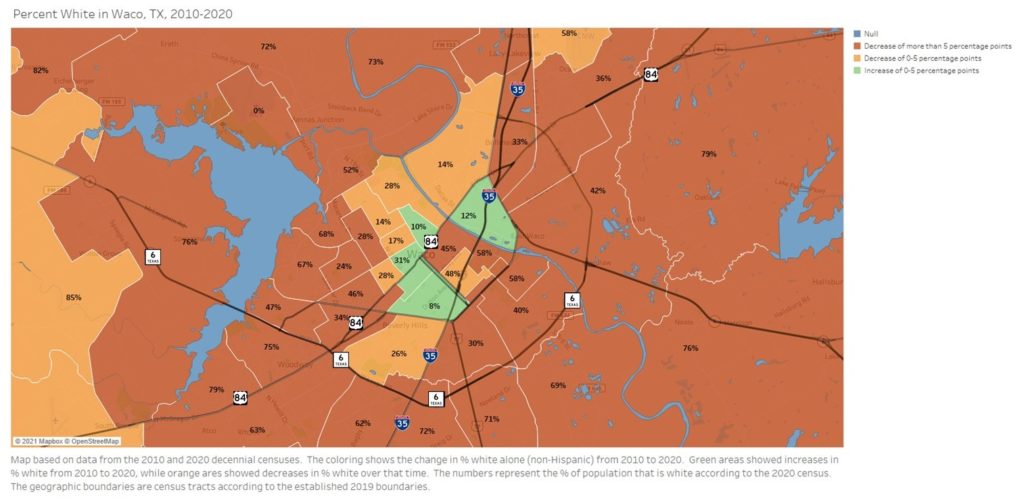
The next map shows the growth and distribution of Black residents in Waco who identify as only Black, non-Hispanic. Unlike the maps for Latinos and Whites, this map shows a mixed story. The tracts are split evenly between those that show growth in percentage Black and those that show decline. East Waco showed a decline in percentage Black, but these areas are still the places in Waco with the highest percentage of African Americans.
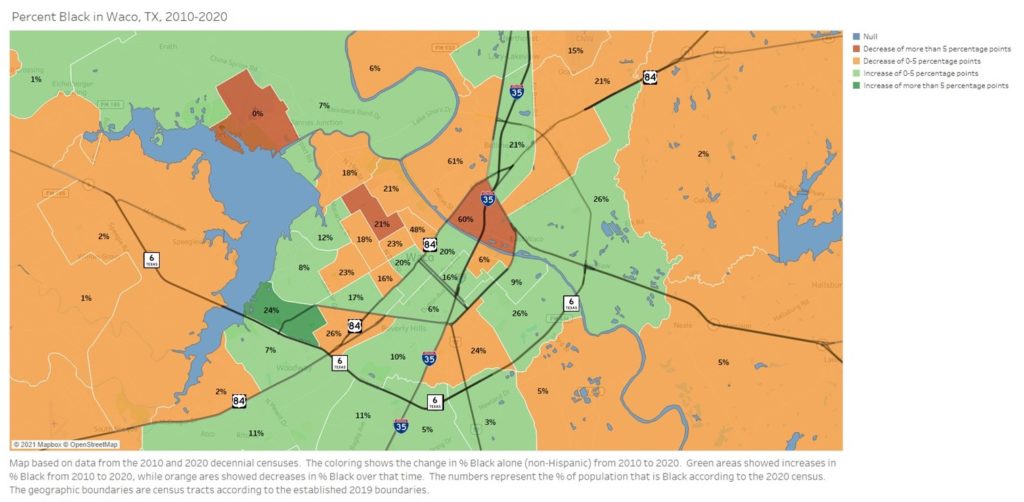
The next map shows the growth and distribution of Asians in Waco, which includes folks who identify with East Asian cultures such as those of China and Korea, Southeast Asian cultures such as those of Vietnam and Indonesia, and South Asian cultures such as those of India and Pakistan. Similar to the story for Latinos, most of Waco has seen an increase in the percentage of residents who identify as Asian. Most of the areas of Central Waco have seen modest increases in percent Asian, though the numbers remain small. In most Waco census tracts, less than 2% of the residents are Asian. The notable exceptions include areas near Baylor University, and the Hewitt/Woodway areas.

The final map shows the percentage of Waco residents who identify with more than one racial identity. All areas have shown growth, and the shade of green shows the amount of growth for that census tract. The areas with the darkest shade of green, mostly within the city limits, have each seen increases of at least 10 percentage points. As I mentioned in the previous post, the increase in multiracial people is caused by 3 reasons.
- Improvements in the census questions allow for a more accurate count
- Reduced stigma for interracial couples has led to more pairings, and more biracial children
- Interracial people are more willing to identify as such than in the past
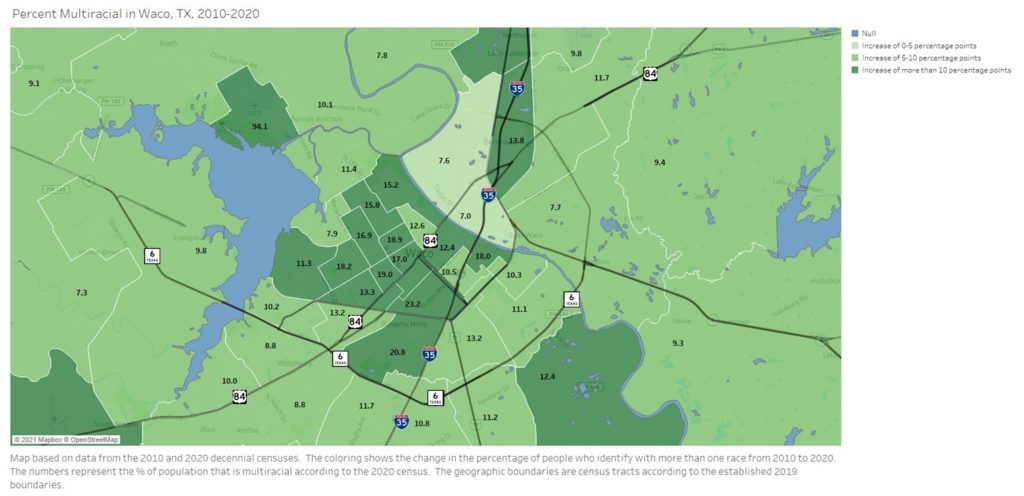
If you have any questions about this, or if you would like Jeremy to give an overview of these changes to your group, staff, or organization through Zoom or in person, please contact Jeremy Rhodes at [email protected].
Jeremy Rhodes, Ph.D., is director of research and community impact for Prosper Waco.
The Act Locally Waco blog publishes posts with a connection to these aspirations for Waco. If you are interested in writing for the Act Locally Waco Blog, please email Ferrell Foster at [email protected].
By Jeremy Rhodes
The first wave of data released from the 2020 US Census is here, and many of the demographic shifts that we’ve seen across the country and the state are mirrored in our Waco community. In this series of posts, I am presenting some of the demographic changes we see in our county from 2010 to 2020. The first post presented numbers regarding general population growth and decline. This second post will show an overview of racial and ethnic changes in the county.
The census website advises caution when comparing the racial and ethnic composition of 2010 to that of 2020. According to their website, “data comparisons between the 2020 Census and 2010 Census race data should be made with caution, taking into account the improvements we have made to the Hispanic origin and race questions and the ways we code what people tell us.”
With that caveat in mind, from 2010 to 2020, the U.S. saw the most dramatic growth among two racial and ethnic groups: Latinos and multiracial people. The U.S. saw a 23% increase in Latinos, while the state of Texas saw a 21% increase in Latinos. In McLennan County, the Latino population increased by 23.6%, or an addition of 13,116 people. Multiracial Americans also saw significant growth throughout much of the United States. In McLennan County, multiracial people now make up 11.8% of the population, which is an increase of 428.6%.
The following table shows a more detailed racial and ethnic makeup for the county, in comparison to Texas and the entire U.S.
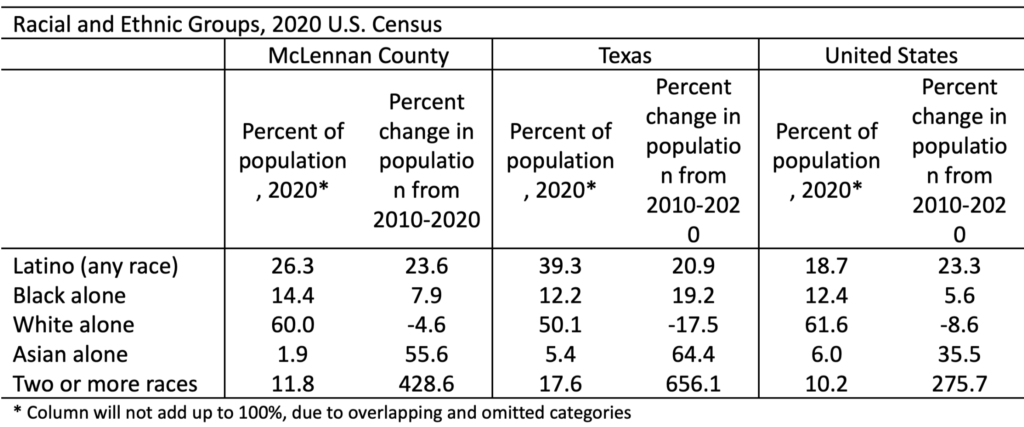
The tremendous growth of multiracial people is caused by multiple factors. The most obvious factor has to do with lessening stigma against interracial relationships. As we come to see more and more interracial pairings, we will have more biracial children being born.
Second, the Census Bureau has improved the way they ask the race/ethnicity question by creating two separate questions for race and ethnicity, which experts believe will provide a more accurate portrait of how people identify (this change is expected to also improve our count of Latinos in America).
Third, there is evidence that multiracial individuals are more willing to identify as such than in the past. For example, a person who has one Black parent and one Latino parent is now less likely to choose between those two identities, and more likely to identify as both.
The next post in this series will display maps that show where we have seen the growth and decline for specific racial/ethnic groups in Waco. If you have any questions about this, or if you would like Jeremy to give an overview of these changes to your group, staff, or organization through Zoom or in person, please contact Jeremy Rhodes at [email protected].

Jeremy Rhodes, Ph.D., is director of research and community impact for Prosper Waco.
The Act Locally Waco blog publishes posts with a connection to these aspirations for Waco. If you are interested in writing for the Act Locally Waco Blog, please email Ferrell Foster at [email protected].
By Jeremy Rhodes
The first wave of data releases from the 2020 US Census is here, and many of the demographic shifts that we’ve seen across the country and the state are mirrored in our Waco community. In this series of four posts, I will present some of the demographic changes we see in McLennan County from 2010 to 2020. This first post will be an overview of the changes in the data reported by the U.S. Census Bureau.
In all, McLennan County saw an increase of 10.9% from 2010 to 2020. The county added an additional 25,673 residents, with a 2020 population of 260,579. Of the McLennan County residents, 53.1%, or 138,486 people, live in the city of Waco. This rate of growth is lower than the Texas growth rate of 15.9%, but higher than the total U.S growth rate of 7.4%.
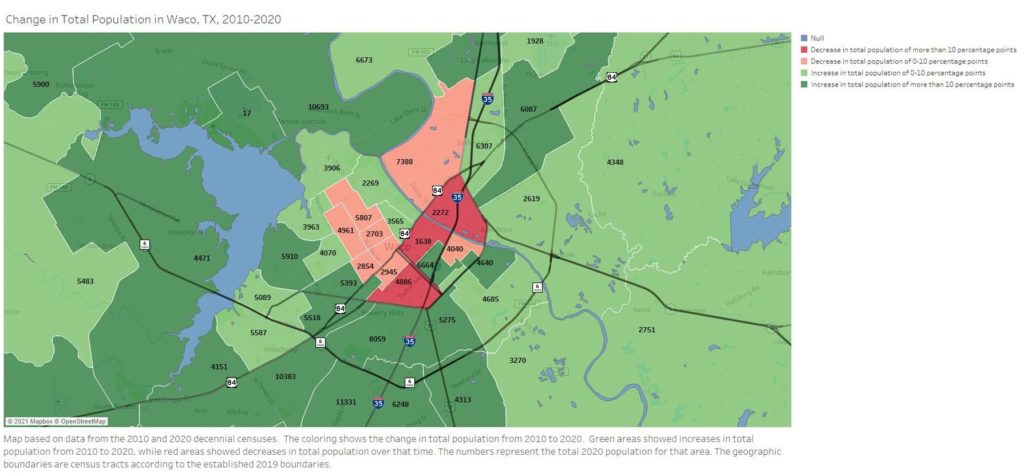
The map shows where we saw growth and decline in McLennan County from 2010-2020. The coloring shows the change in total population. Green areas showed increases in total population, while red areas showed decreases. The numbers represent the total 2020 population for that area. The geographic boundaries are census tracts according to the established 2019 boundaries.
The highest growth rates appear along the outskirts of the Waco city limits, in communities such as China Spring, Speegleville, Woodway, Hewitt, Robinson, and Bellmead. Areas that saw population decline over this time include East Waco, downtown Waco, and the 10 to 15 blocks on either side of the 25th/26th St. corridor, running from I-35 in the southeast to Park Lake Dr. in North Waco. Those areas are also characterized by lower populations than the rest of the city.
In the next posts, we will begin exploring the changing racial and ethnic dynamics of McLennan County. If you have any questions about this, or if you would like Jeremy to give an overview of these changes to your group, staff, or organization through Zoom or in person, please contact Jeremy Rhodes at [email protected].

Jeremy Rhodes, Ph.D., is director of research and community impact for Prosper Waco.
The Act Locally Waco blog publishes posts with a connection to these aspirations for Waco. If you are interested in writing for the Act Locally Waco Blog, please email Ferrell Foster at [email protected].
